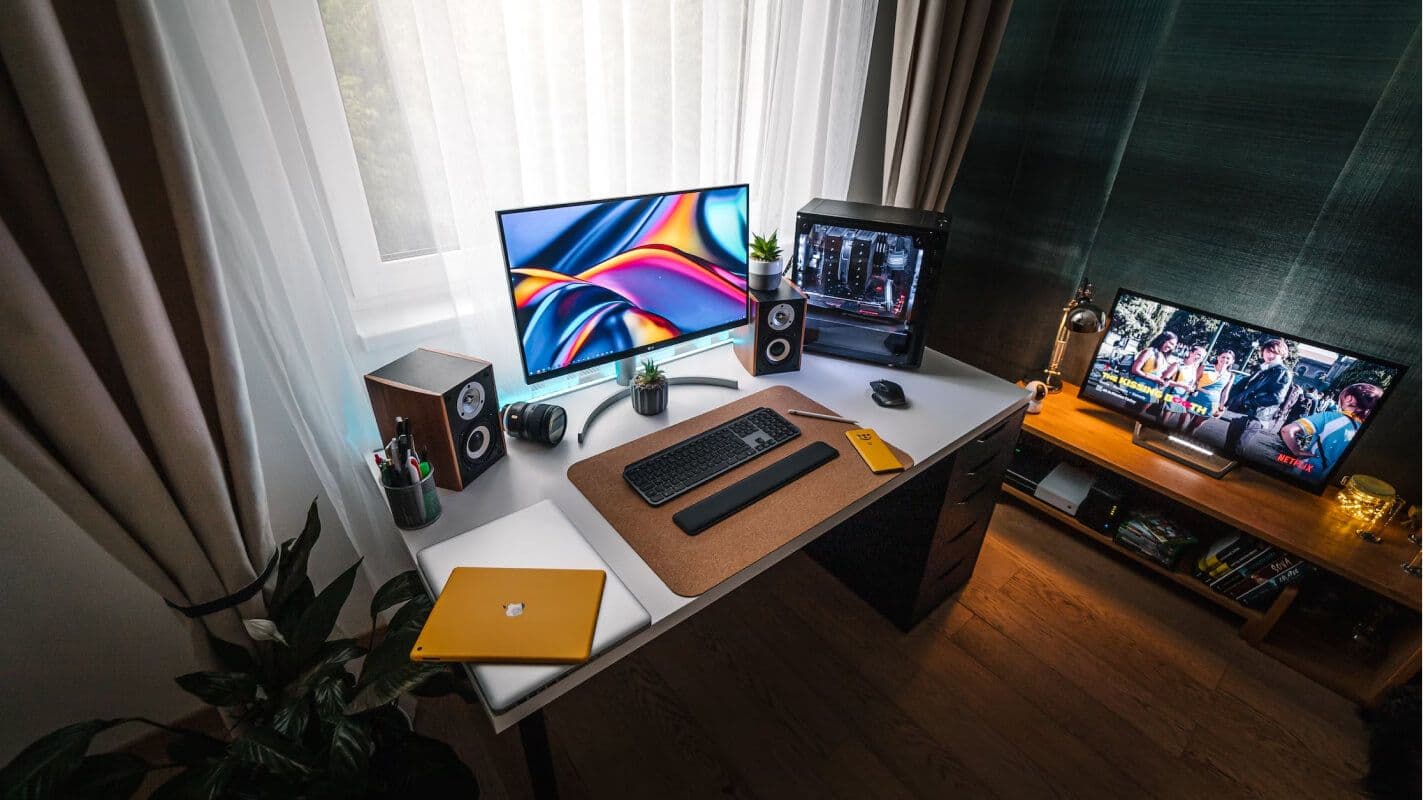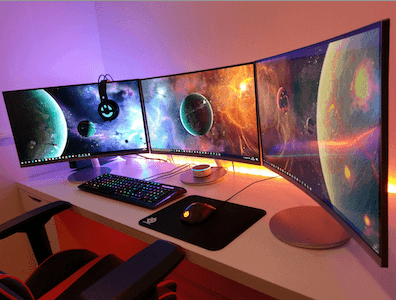
Buying the right monitor at once
Buying a monitor? What to look out for!
The ultimate monitor for any situation
Looking for a monitor for more comfort while working? Or just for next to your desktop which provides the perfect gaming experience? Monitors offer it all. As similar as they are, they each serve a different function. It can therefore be a difficult choice to find the perfect match for you.
A distinction can be made between business, gaming and graphics monitors. Within these three groups, you can again differentiate between image, size and screen. In this blog we will try to guide you to the right choice. And you will soon, hopefully, be sitting super happy behind your new monitor.
Find the perfect monitor size
There are different types of sizes for monitors. There are three ascending sizes, each perfect for different activities. From smaller screens to mega-wide you'll find them from 24 inches to as large as 49 inches. Below we tell you more about three types of sizes, but be sure to check out our website to really find the ideal size for you: there are even more.
You're always right with 27 and 32 inches
The most common is 27 inches, which is 69 cm. This is a pleasant size for progammes, movies or series. And for the office or working from home, this size is perfect. It allows you to multitask between your laptop screen and the monitor. The screen is the perfect size, which makes working easier.
Go a little further with the 32-inch (81 cm). Is your job image processing or graphic designer? Then this screen is the ideal match. It gives a wide viewing angle to your smooth images: just what you need. This screen is also super fine for the gamers among us.
Just make sure you grab the right viewing distance. This should be more than 50 cm. Do you not have a deep desk, so the 50 cm is not possible? Then the 32 inch is superfluous and the 27 inch supports you much better. Also, of course, it is just a question of whether such a size fits in your study or game room. Still, the difference between these large screens and the small screen is definitely noticeable.
Don't need much? Go for 24 inches
The smallest size is 24 inches, aka 61 cm. This PC screen is probably just a little bigger than your laptop. Therefore, it gives extra comfort during daily tasks, such as browsing the Internet, answering your emails or writing texts. The screen is certainly usable during work. In fact, it is large enough to be able to open two windows side by side. Yet during busy work periods it can still cause irritation, the screen is just too small.
You don't have to opt for a larger screen right away. You can also opt for an extra monitor. You can place the two monitors in a kind of triangle on your desk, with your laptop in the middle. This way you create both a cozy workspace and a lot of functionality.
Get carried away with an ultra wide screen
Ultrawide screens are not taller than regular screens. They are wider, and how much wider depends entirely on your preference. In fact, the screens range from 34 to 49 inches. This is 86 to 145 cm is. The screens are not static and straight, but rather curved (curved). Such a large screen is perfect for “workaholics”: in fact, you can keep a lot of tabs open on it. Also, this screen drags gamers into a completely different dimension. Which makes for the best experience.

Enjoy all-day comfort with an adjustable screen
Of course, how the monitor best supports your activities depends on each person and each day. Especially for those who spend long hours behind the monitor, proper support is a necessity. This is why most have adjustable screens. Obviously, screens can raise and lower. Some can also tilt, forward and back, just like your laptop. And some can even rotate. You can do this in two ways: with the portrait or the base. With the portrait you can rotate the screen vertically, and with the foot you can show the screen to your neighbor.
Find the right sharpness through the screen panel
The screen panel affects the picture quality of your new monitor, which comes with a number of advantages and disadvantages. Below, we discuss IPS, VA, TN and OLED panels.
In-Plane Switching (IPS) panel.
The IPS panel is super common and fine for everyone. It has a wide viewing angle and good responsiveness. This ensures that you can work with it with ease. With the IPS, you create the ideal monitor for while working at home, gaming or videotaping. It is not for nothing that this panel, as the best, has captured a large part of the market.
Vertical alignment (VA) panel
The VA panel has a slightly less wide viewing angle. However, the contrast here is very strong, creating super nice color reproduction. Super pleasant while watching the most immersive movies.
Twisted nematics (TN) panel
The TN panel has lower brightness, resulting in lower contrast and aspect ratio. Color reproduction, compared to the VA and IPS panel, is also disappointing. What is even more disappointing are the viewing angles of this panel, which are unfortunately very limited. We therefore recommend one of the other screens for a better experience.
Organic led (OLED) panel
The organic LED panel works accurately with the pixels per inch. In fact, there is no background lighting here, but LED lighting. The pixels ensure that the colors are as dark and vivid as possible. So every movie or game is displayed with quality. You don't seem to want anything else, but beware: with prolonged use of an OLED panel there is a risk of burning in.
What is the frame rate of your monitor?
The frame rate is how fast images follow each other on your monitor. Completely unimportant this is not while working, gaming or chilling out. After all, you want it to have the perfect connection to sound and activities. The frame rate is indicated by a frequency in Hz. For office work or novice gamers, a frequency of 60 Hz is enough. As such, this is the average that most monitors work with. Have you been gaming for a longer time and are used to high speed? Then choose a higher frequency so that your gaming monitor keeps up with your needs!
Step up your game with a G-Sync monitor
For even better visuals while gaming, you can purchase a monitor with G-Sync. G-Sync is a technology that eliminates tearing and stuttering. Now you're probably wondering what that is? We will explain it to you!
When your screen suffers from tearing, you will see multiple images simultaneously. This is because your screen is still processing new images when the next one is already approaching. This creates a blocky effect called tearing.
When your screen suffers from stuttering you will see a repetition of images. Your image cannot keep up with the refresh rate. Now some images keep repeating, until the next image is transmitted. But because the image has stuttered, several images have now been skipped. This creates a choppy image called stuttering.
G-Sync counteracts both of these. So your video card runs in seamless sync with your monitor and you can fully enjoy your immersive games.
How do you choose a gaming monitor?
When you're looking for a gaming monitor, you need to look even more critically at these above points. This is because with gaming monitors, you get to deal with several terms, all of which need to be top to your needs. It is good to find out which panel suits you perfectly and what refresh rate you need for gaming.
The size of your screen is also important. You can go for the ultimate experience with an ultra wide. Or are you more into graphics setup anyway? Then you can go for a 4K monitor. A 4K monitor is even sharper than a Full HD screen. This is not necessary for daily activities or while working, but lets the landscapes and characters during games stand out in fine detail. It also puts you one step ahead of your opponent: you have him or her sharply in your sights.
Do you experience lag or blurry images that prevent you from playing your game? Then purchase a G-Sync, as we mentioned above. G-Sync combats tearing and stuttering. G-Sync 4K monitors are also available.
Connect the monitor in different ways
There are numerous ways to connect your monitor these days. You can choose between different USB ports, such as the USB-C port that you see on many modern laptops today. But the popular HDMI port is also available and suitable for all situations. Among gamers, the DisplayPort is often used: it connects multiple screens together.
The modern USB connections
USB connectors are known for their efficiency, especially the USB-C. This is because the USB-C enables 3 tasks with only one cable. With just one cable, you can import image signals and data. The cable also allows charging your external device. The USB-C supports resolutions up to and including 4K.
Always good with HDMI port
The most common connection today is the HDMI. This connection also supports resolutions up to and including 4K, so a sharp picture is not to be missed. Make sure the cable of the HDMI is not too long, when you buy it. Up to 10 meters there is nothing wrong, but if it is longer, it does not support as well. The connection thus loses power, which can cause you to get choppy images. Almost all desktops and laptops have an HDMI port: so you almost never miss out with this connection.
Never fall short with a DisplayPort
With a DisplayPort, you're going for power. The bandwidth of this charger is higher than that of an HDMI or USB-C. The bandwidth determines the speed of data traffic. With this cable, you have more options. So you have a high refresh rate and the cable can support a high resolution of up to 8K. Daisy Channing is also possible with a DisplayPort. This allows you to connect a monitor directly to another monitor.
How economical is a monitor?
Of course, we at Productpine also talk about the sustainability aspect. Most monitors have an energy label between E and G. You can find out what an energy label is in our blog on sustainable interior design. This seems a bit high, but can be compensated with some tips from the same blog. After all, a monitor is a must-have for a lot of work occasions. Compared to other energy savers in the home, however, an extra screen doesn't beat that.
You are now ready to find your new monitor!
Now all the information about monitors is probably too much to list for a while. Therefore, listed here one more time all the important points, to consider:
- The screen size
- The screen panel
- The frame rate
- The different connections
And last but not least, an adjustable screen for sitting in the right position all day long. Now that you have these points clearly listed again, you can calmly read through the blog again. Hopefully you can now find out which monitor is best for you. Still have questions? Our customer service is happy to tell you more about buying a monitor. Also, did you know that when you make an online purchase at Productpine, 1.5% of your purchase is invested in one of our sustainability projects? And without having to pay more!